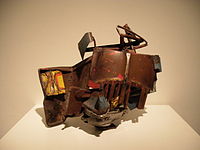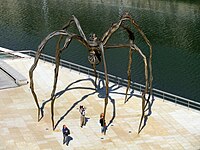Abstract expressionism
Abstract expressionism in the United States emerged as a distinct art movement in the immediate aftermath of World War II and gained mainstream acceptance in the 1950s, a shift from the American social realism of the 1930s influenced by the Great Depression and Mexican muralists.[1][2] The term was first applied to American art in 1946 by the art critic Robert Coates. Key figures in the New York School, which was the center of this movement, included such artists as Arshile Gorky, Jackson Pollock, Franz Kline, Mark Rothko, Norman Lewis, Willem de Kooning, Adolph Gottlieb, Clyfford Still, Robert Motherwell and Theodoros Stamos among others.
Not to be confused with Abstract art, Abstract impressionism, or Expressionism.Years active
Late 1940s–early 1960s
United States, specifically New York City
The movement was not limited to painting but included influential collagists and sculptors, such as David Smith, Louise Nevelson, and others. Abstract Expressionism was notably influenced by the spontaneous and subconscious creation methods of Surrealist artists like André Masson and Max Ernst. Artists associated with the movement combined the emotional intensity of German Expressionism with the radical visual vocabularies of European avant-garde schools like Futurism, the Bauhaus, and Synthetic Cubism.
Abstract Expressionism was seen as rebellious and idiosyncratic, encompassing various artistic styles, and was the first specifically American movement to achieve international influence and put New York City at the center of the Western art world, a role formerly filled by Paris. Contemporary art critics played a significant role in its development. Critics like Clement Greenberg and Harold Rosenberg promoted the work of artists associated with Abstract Expressionism, in particular Jackson Pollock, through their writings. Rosenberg's concept of the canvas as an "arena in which to act" was pivotal in defining the approach of action painters. The cultural reign of Abstract Expressionism in the United States had diminished by the early 1960s, while the subsequent rejection of the Abstract Expressionist emphasis on individualism led to the development of such movements as Pop art and Minimalism.[3] Throughout the second half of the 20th century, influence of AbEx can be seen in diverse movements in the U.S. and Europe, including Tachisme and Neo-expressionism, among others.
The term "abstract expressionism" is believed to have first been used in Germany in 1919 in the magazine Der Sturm in reference to German Expressionism. Alfred Barr used this term in 1929 to describe works by Wassily Kandinsky.[4]
Abstract expressionism and the Cold War[edit]
Since the mid-1970s it has been argued that the style attracted the attention, in the early 1950s, of the CIA, who saw it as representative of the US as a haven of free thought and free markets, as well as a challenge to both the socialist realist styles prevalent in communist nations and the dominance of the European art markets.[57] The book by Frances Stonor Saunders, The Cultural Cold War—The CIA and the World of Arts and Letters,[58] (published in the UK as Who Paid the Piper?: CIA and the Cultural Cold War) details how the CIA financed and organized the promotion of American abstract expressionists as part of cultural imperialism via the Congress for Cultural Freedom from 1950 to 1967. Notably Robert Motherwell's series Elegy to the Spanish Republic addressed some of those political issues. Tom Braden, founding chief of the CIA's International Organizations Division (IOD) and ex-executive secretary of the Museum of Modern Art said in an interview, "I think it was the most important division that the agency had, and I think that it played an enormous role in the Cold War."[59]
Against this revisionist tradition, an essay by Michael Kimmelman, chief art critic of The New York Times, called Revisiting the Revisionists: The Modern, Its Critics and the Cold War, asserts that much of that information concerning what was happening on the American art scene during the 1940s and 50s, as well as the revisionists' interpretation of it, is false or decontextualized.[60] Other books on the subject include Art in the Cold War, by Christine Lindey, which also describes the art of the Soviet Union at the same time, and Pollock and After, edited by Francis Frascina, which reprinted the Kimmelman article.




